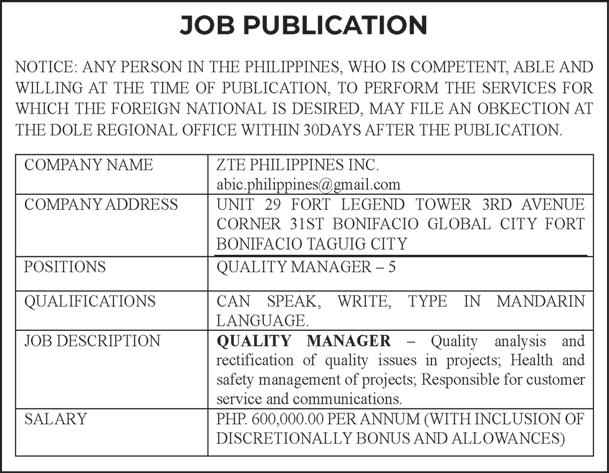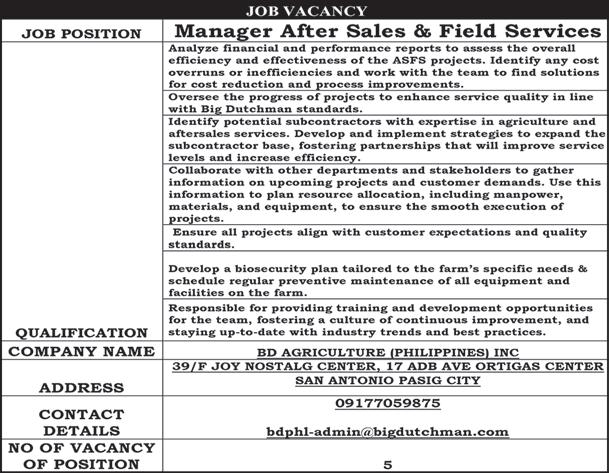
4 minute read
DOLE cites increase in job opportunities for Filipinos
THE Department of Labor and Employment (DOLE) on Thursday reported that job opportunities in the Philippines have increased since the opening 1,190 job fairs nationwide in July last year.
W ith the Public Employment Service
Offices (PESOs), 325,418 job seekers registered to the said job fairs, and 50,849 were hired on the spot, said DOLE. In a news statement, DOLE attributed the increase in job opportunities to RA 11261, or the “First Time Jobseekers Act.”
R A 11261 was signed by then-President Rodrigo Duterte in April 2019, mandating that no fees or charges will be collected from first-time job seekers requesting documents from government agencies.
DOLE and other agencies signed on Ma y 12 the operational guidelines for first-time job seekers.

Secretary Bienvenido Laguesma said that providing effective services for work is one of the primary mandates of DOLE aligned with the Philippine Development Plan 2023-2028.
“Mahalaga ang mga serbisyong pangempleoupangmabilisangtransisyonmula sapaaralantungosatrabaho,atpag-bawas ngmgagastusinsapaghahanapngtrabaho.
[Services for employment are important for efficient transition from school to work, and to minimize expenses for job seeking],” said Laguesma.
A ccording to the Philippine Statistics Authority (PSA), the employment rate as of May 2023 was estimated at 95.7 percent, or 48.26 million employed Filipinos. 46.08 million were reported to be employed last year, May 2022.
Sinc e his second Sona, President Ferdinand R. Marcos Jr. plans to increase the employment rate.
We will generate additional jobs for the overall strategy for infrastructure and medical investments to ensure Filipinos will enjoy a strong primary care and integrated health system in line with the Republic Act No. 11223 or the Universal Health Care Act.



D OH, the Department of Trade and Industry-Board of Investments and Fiscal Incentives Review Board are now set to develop policies, which will help address gaps in the PHFDP.
The said agencies will “study, formulate, and implement policies that will encourage both domestic and international enterprises from the private sector to invest in health facilities.”
B ersamin also tasked DOH to coordinate with the Department of the Interior and Local remaining 4.3 percent of our work force, as well as for the 11.7 percent underemployed Filipinos seeking better employment opportunities,” said Marcos.
Meanwhile, Economic Planning Secretary Arsenio M. Balisacan said job quality still needs improvement, despite the improved employment situation.
W hile the unemployment rate declined to 4.3 percent, Balisacan said that a low jobless rate is different from creating decent jobs that would decrease the poverty rate to 9 percent by 2028.
“ The number of jobs is one thing but the quality of those jobs is another,” said Balisacan on Wednesday during the 2023 Post SONA Discussions. Patrick V. Miguel
Government (DILG) to urge local government units (LGU) to integrate in the PHFDP in their respective Local Investments Plans for Health and Local Development Investment Programs.
I t will encourage LGUs to enter into public-private partnerships (PPP) to secure investments related to public health facilities.
T he health department will submit annual reports to the Office of the Executive Secretary on the implementation of the PHFDP 2020-2040.
It will also issue guidelines for the effective implementation of MC 26.
“The DOH sincerely thanks President Ferdinand R. Marcos Jr. for adopting the
PHFDP aimed at transforming Filipino lives through an integrated health-care system and sustainable health-care facilities and services. By working with national and local government units, we shall be able to establish health-care facilities that can stand the test of time, and build more primary care provider networks, specialty centers, and integrated health-care provider networks within localities. The adoption of the PHFDP is a milestone in health, which will ultimately reinforce the goals of the Department’s 8-point Action Agenda,” said DOH Secretary Teodoro Herbosa in reaction to the Palace issuance of the new MC. Samuel P. Medenilla and Claudeth Mocon-Ciriaco
Where have all the girls gone? PSA reports 5-M Filipino women got married before 20
By Cai U. Ordinario @caiordinario
OVER 5 million women were married even before they reached their 20th birthday, according to the latest data from the Philippine Statistics Authority (PSA).
The data showed 5.178 million Filipinas were married below 15 years old and between 15 and 19 years old. PSA said girls married before reaching 15 years old reached 157,740, while the number of those married between 15 to 19 years old reached 5.02 million.
The data also showed that over half or 3.286 million of these women got married when they reached 18 and 19 years old. A total of 1.699 million were 18 years old when they got married and 1.587 million were 19 years old.
“The median age at first marriage among ever-married women aged 15 to 49 years was 21.6 years, an increase of 0.1 year compared with the 21.5 years posted in 2010. The age at first marriage refers to the age of the woman when she first got married or lived in a consensual union,” the PSA said.
PSA said in terms of region, Calabarzon recorded a total of 714,805 involving women below 15 years old and between 15 and 19 years old.
This was followed by the National Capital Region (NCR) with 520,461; Northern Mindanao, 294,940; Davao Region, 294,689; and Central Visayas, 288,951. The data showed women who got married even before reaching 15 years old was the highest in Calabarzon at 19,238 followed by SOCCSKSARGEN with 13,719; NCR, 12,690; Northern Mindanao, 12,684; and the Bangsamoro Autonomous Region in Muslim Mindanao (BARMM), 11,570.
The PSA said by age group, the median age at first marriage of women aged 15 to 19 years was 17.3 years. It increased to 19.6 years among women aged 20 to 24 years and further to 21 years among women aged 25 to 29 years.
Among women aged 30 years and over, the median age at first marriage averaged at about 23 years. The same trend but with slightly lower values were observed in 2010.
Data showed that among the 17 regions, six had a median age at first marriage higher than the national figure of 21.6 years. These were Region VI-Western Visayas and NCR with 22.4 years each, Ilocos Region and Cordillera Administrative Region with 22.2 years each, and Calabarzon and Central Visayas with 22 years each.
PSA said that BARMM posted the lowest median age at first marriage among regions, with 20.3 years.







